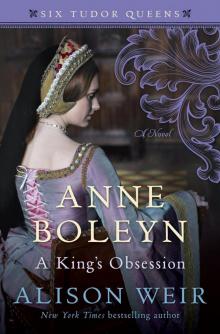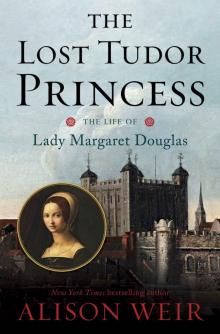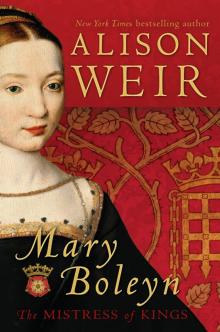- Home
- Alison Weir
Mary, Queen of Scots, and the Murder of Lord Darnley Page 22
Mary, Queen of Scots, and the Murder of Lord Darnley Read online
Page 22
Bothwell’s tailor, George Dalgleish, is said by Buchanan to have been a witness and to have given details of the episode in his confession of 1567, but the extant version of this document does not refer to it. Buchanan also claims that Mary “confessed the whole thing” to Moray and his mother at Lochleven in 1567, “as well as to many others,” but there is no proof of this. It is hardly likely that Lady Reres would have connived at the rape of her mistress, whose escape she had risked her life to facilitate after Rizzio’s murder, and she could not have done so anyway, for she was now lodging in the Prince’s household at Stirling as his wet-nurse. Moreover, it was her sister Janet, the Lady of Buccleuch, who had been Bothwell’s mistress. It will also be remembered that Lennox had dated the commencement of Mary’s alleged affair with Bothwell to before the birth of the Prince.
Some “Notes on David Chambers [sic],” which were later sent to Cecil alleged that Bothwell and his wife were indeed staying in David Chalmers’s house at that time, and that Chalmers got his preferments “because he had served Bothwell as a bawd. He was a great dealer betwixt the Queen and Bothwell, so Mr. David’s lodging was chosen as a place meet to exercise their filthiness, when the Queen lay in the Exchequer House in the Cowgate.”1 This would appear to corroborate Buchanan, but it was written after 1568, at a time when it was vitally expedient to destroy Mary’s reputation and when Buchanan’s libel had been circulated in political circles, so it cannot be relied upon as independent evidence.
According to The Book of Articles, which Buchanan drew up against Mary in 1568, “from September 1566, [Bothwell] became so familiar with her, night and day, that at his pleasure he abused her body,” while Darnley “was never permitted to remain patiently the space of 48 hours together in her company.” If Mary and Bothwell were lovers at this time, then they must have been exceptionally discreet, because no contemporary source mentions such an affair.
Mary was back at Holyrood by 12 September. A week later, Sir John Forster reported that the Privy Council had voted the Queen £12,000 (now equivalent to at least £3.5 million) to cover the expenses of the Prince’s christening; this was to be raised by loans from wealthy Edinburgh merchants. Everyone recognised the necessity for putting on a lavish show of splendour and pageantry in order to impress foreign ambassadors who were used to the magnificent courts of Renaissance Europe.
With Scotland’s international reputation at stake, the Queen naturally desired a degree of unity amongst her nobles, and around this time she persuaded Maitland and Bothwell to make a public display of reconciliation and friendship in the presence of Moray and Argyll, after which, Maitland resumed his duties as Secretary of State.2Mary’s willingness to show favour to these leading Protestants may well have made Darnley all the more determined to expose her as a lukewarm supporter of Catholicism.
On 21 September, Mary, restored to good health and in better spirits,3 left Edinburgh to visit her son at Stirling. The next day, John Beaton arrived from Paris with the subsidy payment and the Nuncio’s letter,4and the day after, Mary returned to Edinburgh to attend to affairs of state. She had been “desirous that the King should have come along with her,”5but Darnley still insisted upon remaining at Stirling. He was in a foul, dejected mood, and revealed to du Croc that he was in such desperation that he was minded to go overseas. Du Croc “could not believe that he was in earnest.”6It has been conjectured that the discovery that Mary was Bothwell’s mistress was enough to make Darnley want to leave Scotland, but, if so, it is surprising that neither he nor Lennox ever referred to it during the days that followed, when they had ample opportunity to do so. It will be remembered that Darnley had not been reticent in his suspicions of Rizzio.
Around 24/26 September, Lennox briefly visited Darnley at Stirling before returning to his estates in Glasgow.7The outcome of their meeting was a letter written by Lennox to Mary, informing her that Darnley was so humiliated by the loss of status consequent upon her denying him the Crown Matrimonial that he intended to go abroad, and had a ship lying ready. According to Buchanan, it was anchored in the Firth of Clyde. Buchanan claims that Darnley meant to go to France or Spain, but Nau says that, “by the persuasion of some dissipated youths, who were his chief companions, he had resolved to go secretly to France, and there to support himself upon the Queen’s dowry.” Lennox told Mary he had tried to dissuade Darnley from going, but had been unable to “make him alter his mind.”8
When Mary read this letter on 29 September, she resolved to have the matter out immediately with Darnley. His threat to go abroad was not only a public affront to her but also a threat to her security and that of her realm and her heir, and may have been a form of blackmail; in any case, it had to be dealt with. Some writers have speculated that Mary’s alarm arose chiefly from fear of the scandal that would ensue if her husband went abroad and she then became pregnant by Bothwell, but of course there is little reliable evidence that she and Bothwell were lovers at this time.
Mary showed Lennox’s letter to the Council, who expressed astonishment that the King should “entertain any thought of departing after so strange a manner” from Scotland and his wife, but they had probably not taken into account the humiliation he felt and his mortal fear that Morton and his other deadly enemies would be repatriated. Nor did they know of his dealings with influential Catholics abroad. “Their Lordships therefore took a resolution to talk with the King, that they might learn from himself the occasion of this hasty deliberation of his, that they might thereby be enabled to advise Her Majesty after what manner she should comfort herself in this conjecture.”9
That evening, to everyone’s “amazement,” Darnley turned up at the gates of Holyrood, but refused to enter the palace until the Privy Councillors had been dismissed, a stipulation that greatly offended those Lords. At 10 p.m., the Queen had to go out and persuade him that he was insulting her by his behaviour and should come inside. Because of the state he was in, she “conducted him to her own apartment, where he remained all night, abed together,” but he resisted her attempts to make him state his grievances. However, he did agree to attend a meeting of the Privy Council in the morning.10
Yet they fared little better. Having told the King that he should thank God for such a wise and virtuous wife, the Councillors asked him to account for his behaviour, and inform them how they had offended him. Mary herself took him by the hand and made him “a pretty strong harangue,” begging him to tell her if she had given him any cause to leave the kingdom, and declaring that she had “a clear conscience, [and] that all her life she had done no action which could anywise prejudice either his or her honour.” But Darnley refused to admit either that he intended to go abroad or that he had any cause for complaint. Du Croc, who was present, bluntly told him that his leaving the country “must affect either his own or the Queen’s honour.” At this, Darnley “at last declared that he had no ground at all for leaving the country” and that Mary had given him no occasion for discontent. “Thereupon he went out of the chamber of presence, saying to the Queen, ‘Adieu, Madame. You shall not see my face for a long space.’ After which, he likewise bade [du Croc] farewell, and, turning to the Lords, said, ‘Gentlemen, adieu.’ ”
After his departure, Mary was visibly distressed, but du Croc and the Lords comforted her, saying they were “all of opinion that this was but a false alarm the Earl of Lennox was willing to give Her Majesty.” The best advice they could give her was to continue on her present course of wise and virtuous behaviour, for the truth about her marriage would soon be public knowledge.11The Lords would hardly have said this to her had she been carrying on with Bothwell, whom they hated.
Against Mary’s wishes,12Darnley immediately left Holyrood for Glasgow, accompanied by Lennox. From Corstorphine, he wrote to her revealing that he was still in a mind to leave the country since she did not trust him with any regal authority, “nor is at such pains to advance him and make him to be honoured in the nation as she at first did”; furthermore, he complained, the nobilit
y shunned him. On hearing this, the Council declared that they would never consent to his having the disposal of public affairs. Mary herself sent Darnley a letter in which she pointed out that, if his status was diminished, he ought to blame himself, not her, for that, in the beginning, she had conferred so much honour upon him as came afterwards to render herself very uneasy, the credit and reputation wherein she had placed him having served as a shadow to those who have most heinously offended Her Majesty; but she has, notwithstanding this, continued to show him such respect that, although they who did perpetrate the murder of her faithful servant had entered her chamber with his knowledge, and had named him the chief of their enterprise, yet would she never accuse him thereof.
Furthermore, “if the nobility abandon him, his own deportment towards them is the cause thereof; for if he desire to be followed and attended by them, he must first make them love him.”13Mary also wrote to Lennox, assuring him that Darnley had no cause for complaint.
The King’s behaviour carried serious implications. On 8 October, on Mary’s instructions, the Council sent a full account of her confrontation with him and the correspondence that followed to Catherine de’ Medici, just in case Darnley should appeal to the French for support. It was stressed that the Lords would have been joyfully disposed “to pass over in silence the huge injury he does to himself and the Queen’s Majesty but, seeing that he himself is the very first person who, by his deportment, will lead discovery to the world, we can do no less than to testify the things that we have both seen and heard [to] all those who are allied to Her Majesty, that by these you may have opportunity to perceive the great trouble and vexation the Queen labours under at present, and the occasion of it.”14
Soon after his departure, Darnley had sent a message to du Croc, summoning him to meet him halfway between Edinburgh and Glasgow. He had decided to make public his grievances in the hope that the ambassador would use his influence to put matters right. But du Croc “remonstrated to him every thing that I could think of” to dissuade him from leaving Scotland, and came away with the impression that he had succeeded. Darnley, however, arrived in Glasgow more resentful than ever. Nor did he stay there long, for in October he was in Fife, hunting at Burleigh Castle and Kinross, and fishing at Loch Leven.
Late in September, as Mary had anticipated, the Council, with Moray at his most vociferous, refused permission for the Papal Nuncio to come to Scotland.15Even the militant Pius V was having doubts as to the wisdom of Mondovi’s mission, for he felt that its success was largely dependent upon Philip II being in Flanders, and on 30 September he wrote to the Nuncio to say that, if Philip’s arrival was further delayed, he should return to his See.16Unknown to him as yet, Mary was still making concessions to the reformed Church: in Council, on 3 October, she agreed that all benefices under 300 marks should go to ministers of the Kirk.17
Mary was more preoccupied with the need to establish good order in the Borders18, and decided to go ahead with the assizes that had been postponed, initially because of her pregnancy and then because of the harvest. On 1 October, she summoned all her Border Lords and freeholders to meet her at Melrose on 8 October, prior to travelling to Jedburgh for a justice eyre, or circuit court, over which she intended to preside on the 9th.19Darnley, invited to accompany her, had refused; Lennox claims that Mary’s progress to the Borders was a ploy to get away from her husband,20but of course he had absented himself from her.
It was essential, in the circumstances, that there was at least a show of unity between the leading nobles and, early in October, according to Moray,21 the Queen forced him, Argyll, Bothwell and Huntly to “subscribe a bond, which was devised in sign of our reconciliation in respect of the former grudges and displeasures that had been amongst us.” Moray claims he “was constrained to make promise before I could be admitted to the Queen’s presence or have any show of her favour”: evidently Mary had been obliged to use her royal prerogative to bend him to her will. The Bond bound these Lords to fortify and support each other in all their undertakings against their enemies and in refusing to obey the King “when his orders conflicted with the Queen’s wishes.”22This put an end to Bothwell’s support of Darnley, and left the latter politically isolated, which is probably what Mary intended.
On 6 October, Bothwell, as Lieutenant of the Borders, left Edinburgh with 300 horse for Liddesdale, one of the most lawless regions in the Borders, to begin rounding up the worst troublemakers, who were to receive judgement at the Queen’s justice eyre. Buchanan alleges that the Earl “conducted himself neither according to the place which he held, nor the dignity of his family,” yet, as a result of his efforts, members of the violent Armstrong and Johnstone clans were imprisoned in Hermitage Castle. However, the notorious Elliotts, a family of Border reivers, remained at large, so Bothwell now turned his attention to tracking them down.
On 7 October,23Mary, accompanied by Moray, Huntly, Atholl, Livingston, Seton, Caithness, Rothes, Maitland, Bishop Leslie and other Lords, as well as a host of household officers, judges, lawyers, clerks, waiting women, servants and men-at-arms, left Edinburgh for Borthwick Castle, the first stop on her progress. As the cavalcade wended its slow way south, Bothwell was engaging in an affray with the Elliotts, in the course of which he was severely wounded by one of them, the vicious outlaw, Jock Elliott of the Park.24Having received stab wounds to the forehead, thigh and left hand, “Bothwell was carried to his castle of Hermitage in a condition such as to make his recovery uncertain.”25But, in his absence, the fortress had been taken over by the thieves and malefactors whom he had imprisoned there, and they would not surrender it until they had been granted their freedom. Bothwell’s officers had no choice: “if he had not gotten in at that time, all his company had been slain.”26So the Earl was carried in, unconscious and bleeding, and “everyone thought he would die.” When he regained consciousness, “he thought so himself.”27
The news spread fast, but became garbled in the telling. On the following day, Henry, Lord Scrope, informed Cecil, from Carlisle, that Bothwell had been slain in the attack.28Soon afterwards, it was being reported in Europe that the Queen of Scots had “lost a man she could trust, of whom she had but few.”29
Surprisingly, Mary had not yet heard of the attack on Bothwell. She left Borthwick on 8 April and travelled via Peebles and Selkirk to Melrose, where she was met by her assembled lieges. On the following day, she arrived in Jedburgh and took up residence in what is now the Spread Eagle Hotel, and it was here that she learned that Bothwell was lying seriously wounded at Hermitage.30She did not “fly like a madwoman” immediately to visit him, being unable to restrain her “inordinate affection” and “shameless lust,” as Buchanan later alleged, but set up her court in the Tolbooth and, for the next six days, dispensed justice. However, thanks to the escape of the Armstrongs and Johnstones from Hermitage, there were very few cases to be heard, and Moray complained that Mary was far too merciful to those who did come before her, none of whom was sentenced to death as he felt they deserved, but merely fined.31
Melville claims that Bothwell and Huntly had planned to murder Moray at Jedburgh, but that Lord Home arrived there with a force of men “and prevented that enterprise.” It is more likely, however, that this plot was foiled by Bothwell’s incapacity.
On 9 October, Mary summoned one Stephen Wilson, whom she had chosen to act as her messenger to the Papal Nuncio, and instructed him to tell Mondovi that the nobility had agreed to his coming. It is less likely that they had changed their minds than that Mary was playing for time, which was to be granted her, for Wilson, due to unforeseen and near-tragic circumstances, was not to depart for a month.
Du Croc had formed the opinion that Darnley wanted to be and command all, and suffered mainly from wounded pride. Wishing to inform Mary’s friends abroad of the truth, the ambassador wrote letters to Archbishop Beaton on 13 October,32and to Catherine de’ Medici on 16/17 October,33recounting the events of late September. Referring to Darnley’s threats to go abroad, he
wrote, “He has not embarked, but we receive advertisements from day to day that he still holds on to his resolution and keeps a ship in readiness. It is in vain to imagine that he should be able to raise any disturbance, for there is not one person in all the kingdom, from the highest to the lowest, that regards him any further than is agreeable to the Queen. And I never saw Her Majesty so much beloved, esteemed and honoured.”
Du Croc also described preparations for the coming baptism, saying that both Protestants and Catholics were enthusiastic about it, but that the fuss being made probably accounted for Darnley’s bad behaviour; apparently, he was bitterly jealous of Mary’s good relations with the Protestant Lords, and fearful that his reduced status would be apparent to all the foreign dignitaries who attended the christening, which would be intolerable for one of his “lofty and vainglorious” temperament.34
In Paris, on 15 October, Mondovi, concerned that Mary had not responded to his letter, sent by John Beaton over a month before, and correctly concluding that she was stalling, met with the Cardinal of Lorraine, but had “great difficulty in persuading him that there ought not to be further delay in doing something signal for the service of God in Scotland.” At length, the Cardinal reluctantly agreed to send a gentleman to persuade Mary to admit the Nuncio and “decide on restoring Holy Religion in her kingdom.” A week later, Mondovi had a second meeting with the Cardinal, to tell him that the Pope had recalled him to his See; the Cardinal begged him to await the return of his gentleman from Mary’s court.35There is, however, no trace of any such gentleman being sent to Scotland at this time; circumstances will reveal, however, that the Cardinal probably dispatched someone in late October.36

 Richard III and the Princes in the Tower
Richard III and the Princes in the Tower Britain's Royal Families: The Complete Genealogy
Britain's Royal Families: The Complete Genealogy The Lady in the Tower: The Fall of Anne Boleyn
The Lady in the Tower: The Fall of Anne Boleyn Six Wives of Henry VIII
Six Wives of Henry VIII Elizabeth of York: A Tudor Queen and Her World
Elizabeth of York: A Tudor Queen and Her World Captive Queen
Captive Queen Innocent Traitor
Innocent Traitor The Marriage Game
The Marriage Game A Dangerous Inheritance
A Dangerous Inheritance Katherine of Aragón: The True Queen
Katherine of Aragón: The True Queen The Marriage Game: A Novel of Queen Elizabeth I
The Marriage Game: A Novel of Queen Elizabeth I Princes in the Tower
Princes in the Tower Anne Boleyn: A King's Obsession
Anne Boleyn: A King's Obsession Traitors of the Tower
Traitors of the Tower Mistress of the Monarchy: The Life of Katherine Swynford, Duchess of Lancaster
Mistress of the Monarchy: The Life of Katherine Swynford, Duchess of Lancaster Queens of the Conquest: England’s Medieval Queens
Queens of the Conquest: England’s Medieval Queens Eleanor of Aquitaine: A Life
Eleanor of Aquitaine: A Life Mary, Queen of Scots, and the Murder of Lord Darnley
Mary, Queen of Scots, and the Murder of Lord Darnley Henry VIII: The King and His Court
Henry VIII: The King and His Court Queen Isabella: Treachery, Adultery, and Murder in Medieval England
Queen Isabella: Treachery, Adultery, and Murder in Medieval England Katheryn Howard, the Scandalous Queen
Katheryn Howard, the Scandalous Queen Arthur- Prince of the Roses
Arthur- Prince of the Roses The Wars of the Roses
The Wars of the Roses Eleanor of Aquitaine: By the Wrath of God, Queen of England
Eleanor of Aquitaine: By the Wrath of God, Queen of England Mary Boleyn: The Great and Infamous Whore
Mary Boleyn: The Great and Infamous Whore Jane Seymour: The Haunted Queen
Jane Seymour: The Haunted Queen Anna of Kleve, the Princess in the Portrait
Anna of Kleve, the Princess in the Portrait Lancaster and York: The Wars of the Roses
Lancaster and York: The Wars of the Roses The Grandmother's Tale
The Grandmother's Tale The Princess of Scotland (Six Tudor Queens #5.5)
The Princess of Scotland (Six Tudor Queens #5.5) The Lady Elizabeth
The Lady Elizabeth Katherine Swynford: The Story of John of Gaunt and His Scandalous Duchess
Katherine Swynford: The Story of John of Gaunt and His Scandalous Duchess The Curse of the Hungerfords
The Curse of the Hungerfords The Lost Tudor Princess: The Life of Lady Margaret Douglas
The Lost Tudor Princess: The Life of Lady Margaret Douglas Eleanor of Aquitaine
Eleanor of Aquitaine Mistress of the Monarchy
Mistress of the Monarchy The Lost Tudor Princess
The Lost Tudor Princess Henry VIII
Henry VIII Anne Boleyn, a King's Obsession
Anne Boleyn, a King's Obsession A Dangerous Inheritance: A Novel of Tudor Rivals and the Secret of the Tower
A Dangerous Inheritance: A Novel of Tudor Rivals and the Secret of the Tower Elizabeth of York
Elizabeth of York Katherine of Aragon, the True Queen
Katherine of Aragon, the True Queen Katherine Swynford
Katherine Swynford Wars of the Roses
Wars of the Roses Queens of the Conquest
Queens of the Conquest Mary Boleyn
Mary Boleyn Britain's Royal Families
Britain's Royal Families The Tower Is Full of Ghosts Today
The Tower Is Full of Ghosts Today Life of Elizabeth I
Life of Elizabeth I Anne Boleyn A King's Obssession
Anne Boleyn A King's Obssession Lancaster and York
Lancaster and York Jane Seymour, the Haunted Queen
Jane Seymour, the Haunted Queen Queen Isabella
Queen Isabella The princes in the tower
The princes in the tower